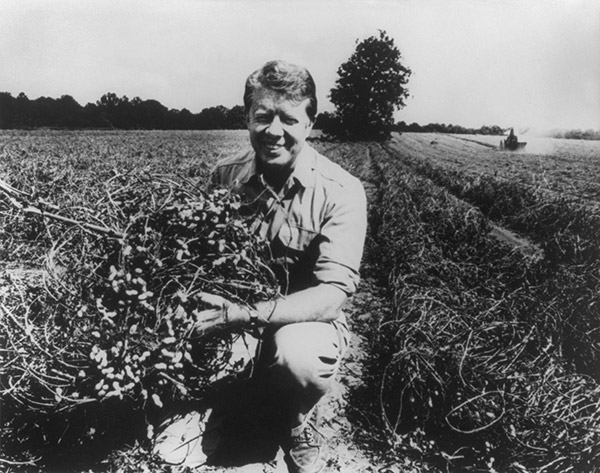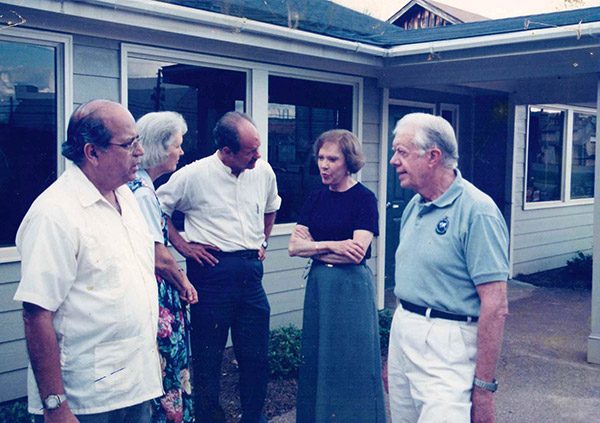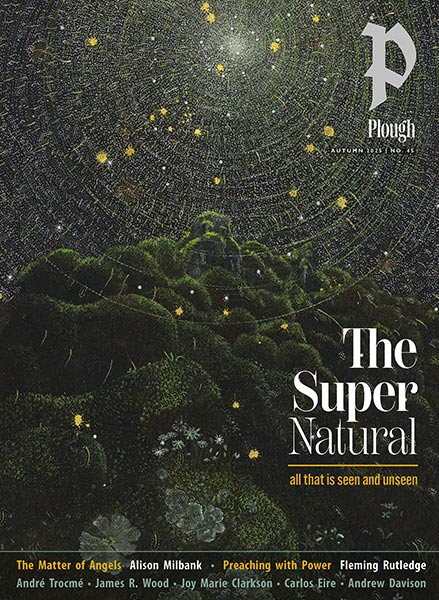Subtotal: $
Checkout
My Neighbor Jimmy
I don’t remember Jimmy Carter as a politician – he was a neighbor who cared about putting love into action.
By Don Mosley
August 2, 2025
In 1970, my wife, Carolyn, and I moved to Koinonia Farm in Americus, Georgia. This Christian community founded in 1942 by Clarence and Florence Jordan and Martin and Mabel England was determined to befriend people of all ethnicities in spite of racial segregation and numerous attacks on the community by the KKK (more than two dozen bullet holes could be seen in the buildings on the premises, though fortunately no one had been killed). In the midst of adjusting to this exciting but demanding life of faith, we heard that a peanut farmer named Jimmy Carter from Plains, a little town eight miles up the road, had just become governor of Georgia.
The children from Koinonia, both black and white, attended the newly integrated public schools. A few years after our move to Koinonia Farm, Carolyn was elected to serve as president of the parent teacher association at Plains Elementary, where our son, Tony, was attending. Carolyn sometimes led meetings inside the school while I helped supervise the students out on the playground, including Jimmy and Rosalynn Carter’s daughter, Amy, who was about the same age as our son.
Our common concern for the public schools our children attended brought us close to the Carters. Jimmy had begun his political career on the local Sumter County Board of Education just a few years after the racial integration of public schools had become a requirement by federal law in 1954. He had discovered that many of the other board members were determined to save their tax money by letting the school buildings deteriorate around the students – who were mostly black and poor – while sending their own children to segregated private schools. This blatant racism, and his belief in a common public education for all, motivated him to move into politics. The Carters would later show that their belief in racial integration and equality was more than political talk when they enrolled Amy in a historically black elementary school in Washington, DC, making them the second (and, so far, last) presidential family to send their children to public school.

Jimmy Carter on his peanut farm in Plains, Georgia, 1976. Photograph by Everett Collection Historical / Alamy.
I too became aware of the terrible condition of the local schools. One high school was in such bad shape that the roof caved in on the central auditorium. Incredibly, students were still instructed in the rickety classrooms that surrounded the rubble. When I began attending the Sumter County Board of Education meetings and witnessed firsthand the racism and anger that had prompted the Carters to enter into politics a few years before, I founded the Sumter County Organization for Public Education – or SCOPE – with the goal of bringing attention and aid to the dilapidated buildings and unsuitable learning conditions for students in regional public schools. We brought attention to the plight of the buildings, for example, by inviting a local television station to film how water poured onto students’ desks on rainy days. While the Carters were racing around the country campaigning for Jimmy’s presidency, we went to court to fight for the Board of Education to repair the schools and build new ones as needed. The Carters won, and so did we.
While Jimmy and Rosalynn were in Washington, we attended a racially integrated church with Jimmy’s mother, Lillian, whom he often credited with raising him with the determination to put love into action. She worked tirelessly for racial integration, and was also the one who had gotten Jimmy started teaching Sunday school as a teenager, a tradition which he would continue until the last years of his life. But Jimmy did not just teach lessons about the love of Jesus – he went out and put that love into action.
One day, shortly after returning to Plains at the end of his presidency in 1981, Jimmy and I sat on the sofa in his mother’s living room for over an hour, discussing an idea that he had just begun to explore – how to use his influence as a former president to promote peace, health, and justice, not only in the United States but around the world. Never in my wildest dreams could I have imagined the humanitarian work the Carter Center would accomplish in dozens of countries around the world over the decades to come. In every initiative, whether domestic or international, the Carters’ chief motivation was to treat people with love as Jesus taught and demonstrated during his time on earth.

(R-L) Jimmy and Rosalynn Carter, Don and Carolyn Mosley, and Nicaraguan pastor Gustavo Parajón converse outside a restaurant in Plains, Georgia, in the late 1980s. Photograph courtesy of Don Mosley.
In addition to the work of the Carter Center, both Jimmy and Rosalynn were known for their work with Habitat for Humanity. Millard Fuller and I had worked on housing projects at Koinonia Farm, which gave birth to Habitat for Humanity while the Carters were still in Washington. It was a few years later that Jimmy and I were having one of our many conversations in their living room in Plains when he suddenly exclaimed, “I think I’d like to be on Habitat’s Board of Directors.” Extremely surprised, I tried to persuade him that he would be bored by the endless hours of discussion involved in being on the board. “No, I’m serious,” he said. Millard was thrilled. Habitat for Humanity had already expanded far beyond what we had initially anticipated, but with Jimmy and Rosalynn’s participation, the growth accelerated even more. Having a former president and first lady out working on houses for disadvantaged families was an inspiration to thousands of others to join service projects like these.
Carolyn and I eventually moved three hours away from Plains to Jubilee Partners, a Christian community in northeastern Georgia whose mission is to help refugees from around the world to resettle in the United States. We kept in touch with the Carters, however, and the experiences we’ve shared with Jimmy and Rosalynn over the last half century could fill a book.
What stood out the most to me in all of this was seeing each of them consistently demonstrate the love that Jesus called us to put into action, rather than just talking about it. Carolyn and I told them this on one of our last visits to the Carters, after the four of us had held hands and prayed together. “Oh, thank you,” Rosalynn responded as Jimmy smiled and nodded. “We appreciate it so much when people think of us like that instead of as just a couple of retired political officials.”
Already a subscriber? Sign in
Try 3 months of unlimited access. Start your FREE TRIAL today. Cancel anytime.







$name